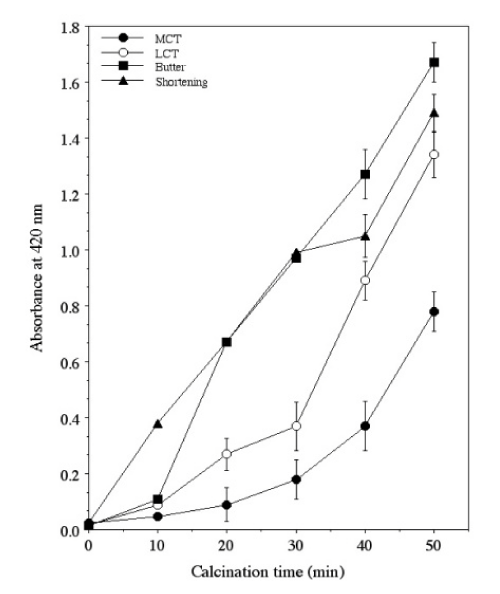
Editorial
Austin J Nutri Food Sci. 2014;2(6): 1033.
Studies of Food Science Functional Properties Related to Medium-Chain Triacylglycerols (MCT)
Toshiyuki Toyosaki*
Department of Foods and Nutrition, Koran Women's Junior College Fukuoka, Japan
*Corresponding author: :Toshiyuki Toyosaki, Koran Women's Junior College, Yokote 1-2-1, Minami-ku, Fukuoka 811-1311, Japan
Received: February 20, 2014; Accepted: March 20, 2014; Published: March 21, 2014
Relationship between the MCT and Maillard Reaction in the Baking Bread
Introduction
Medium-Chain Triacylglycerols (MCT) composed exclusively of medium chain fatty acids (C8 and C10) were first used in the 1950s for dietary treatment of malabsorption syndromes caused by rapid absorption. Since then, they have been widely studied. Although a large number of excellent reports have been published, most of these focus on clinical nutritional or biochemical standpoints [1-9].
We previously reported the somewhat interesting finding that, when an MCT is added during the fermentation of bread dough, fermentation of the dough is enhanced. Based on this result, we concluded that MCT are effective for improving bread quality. We also recently found that MCT inhibit the Maillard reaction, which occurs during the baking of bread. The Maillard reaction is a dynamic reaction that occurs during the bread-making process, and is thought to significantly affect the appearance of the baked bread, as well as its flavor and texture. It plays a significant role in the formation of brown color on the surface of bread during baking, and we found that different shades of brown are produced by the Maillard reaction depending on the presence of added lipids, and whether they are solid or liquid. This strongly suggests that the properties of added lipids have some effect on the Maillard reaction, but there have been no reports on these effects. Therefore, we aimed to investigate from various points of view the mechanisms by which MCT are involved in the Maillard reaction during the baking process.
Conclusion
AGEs are produced by the Maillard reaction that occurs during the bread baking process. This study revealed that adding liquid oil (in particular MCT) inhibits the amount of AGEs produced, and we believe this finding is novel. We also found that this is caused by the fact that medium chain saturated fatty acids, C8 and C10, which are the constituent fatty acids of MCT, are strongly involved in the Maillard reaction, resulting in inhibition of the Maillard reaction. Furthermore, the pore distribution after baking was found to be strongly related to AGEs (Figure 1).
Figure 1: Changes in amount of AGEs produced by the Maillard reaction during baking.
Studies of Comparison of Expansion during Fermentation on MCT Oil-Based and Butter Fat-Based Doughs
Introduction
The functional aspects of introducing MCT oil-based have not been highlighted yet. The current work provides a somewhat interesting finding: when MCT oil-based was added during the fermentation of bread dough, fermentation of dough was promoted. The phenomenon by which gluten produced by MCT oil-based promotes the fermentation of bread dough is decidedly not beneficial when assessed from a nutritional standpoint, but this phenomenon is extremely desirable when assessed from a food science standpoint.
We want to clarify the value and importance of the MCT oilbased. The object of the current study was to investigate expansion during fermentation on MCT oil-based doughs compared to butter fat-based doughs, and the mechanism of expansion during dough fermentation on MCT oil-based was also investigated.
Conclusion
The current research demonstrated that well-fermented dough can be produced by the induction of MCT oil-based when fermenting dough. The induction of MCT oil-based was achieved in the current study by fat-based (butter) induction, but a similar phenomenon should also occur with MCT oil-based induced by other methods. This phenomenon is advantageous when baking bread and can be used to enhance the quality of baked bread. Based on the results of these tests of physical properties, further detailed study is needed of the effect of MCT oil-based on the flavor of baked bread.
Mechanism of expansion of fermentation on MCT oil-based doughs was discussed. Gluten is formed of gliadin and glutenin. Gluten was denatured by MCT oil-based, which gluten molecule grows large (Figure 2). Fermentation is promoted by this phenomenon. This fact can provide new information to the bread-making industry.
Figure 2: The mechanism of the fermentation accelerator of MCT.
References
- Lavau MM, Hashim SA. Effect of medium chain triglyceride on lipogenesis and body fat in the rat. J Nutr. 1978; 108: 613-620.
- Geliebter A, Torbay N, Bracco EF, Hashim SA, Van Itallie TB. Overfeeding with medium-chain triglyceride diet results in diminished deposition of fat. Am J Clin Nutr. 1983; 37: 1-4.
- Chanez M, Bois-Joyeux B, Arnaud MJ, Peret J. Metabolic effects in rats of a diet with a moderate level of medium-chain triglycerides. J Nutr. 1991; 121: 585-594.
- Kris-Etherton PM, Yu S. Individual fatty acid effects on plasma lipids and lipoproteins: human studies. Am J Clin Nutr. 1997; 65: 1628S-1644S.
- Kritchevsky D, Tepper SA. Influence of medium-chain triglyceride (mct) on cholesterol metabolism in rats. J Nutr. 1965; 86: 67-72.
- Leveille GA, Pardini RS, Tillotson JA. Influence of medium-chain triglycerides on lipid metabolism in the rat. Lipids. 1967; 2: 287-294.
- Gary L Ecelbarger, John B Lasekan, Denise M Ney. In vivo triglyceride secretion and hepatic and plasma lipids in rats fed medium-chain triglycerides, tripelargonin, or corn oil. J. Nutri. Biochem. 1991; 2: 260-266.
- Papamandjaris AA, MacDougall DE, Jones PJ. Medium chain fatty acid metabolism and energy expenditure: obesity treatment implications. Life Sci. 1998; 62: 1203-1215.
- Seaton TB, Welle SL, Warenko MK, Campbell RG. Thermic effect of medium-chain and long-chain triglycerides in man. Am J Clin Nutr. 1986; 44: 630-634.

